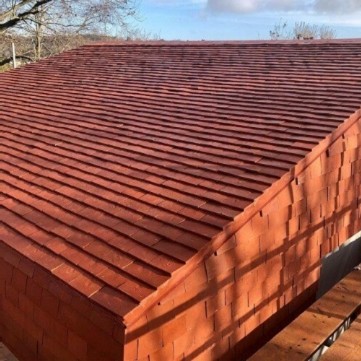Clayhall Roof Tiles in Buckinghamshire
Heritage Tiles: Emblematic of the finest craftsmanship
Heritage tiles are the professional roofer's choice for the highest quality clay roof tiles. We pride ourselves in manufacturing, stocking, and delivering the very finest in prestige clay roof tiles.
Heritage Tiles have several tile ranges that satisfy every architectural requirement. Vintage and historic properties right up to modern new builds are covered by the diverse range of clay roof tiles that we stock.
So, whether you are in the building trade, or simply wish to choose your own tiles, Heritage Tiles have the right product for your specific requirements.
What Heritage Tiles have to offer our customers?
- We offer specification and technical solutions to help you achieve the perfect build.
- We also offer expert design advice to all our customers.
- We are happy to engage in site visits with our clients.
- We have stockists and distributors throughout the United Kingdom to ensure that we can provide our expert service to a wider area.
- We can provide estimated quantities from plans supplied by our clients.
- We offer battening plans.
- We can deliver a standard and bespoke colour choice for our clay tile products.
- All our tiles are assessed and approved by Lucideon.
- We provide a nationwide delivery and collection service.
The ranges of clay roof tiles we supply.
The Clayhall Range of roof tiles:

Clayhall Medium Blend - Carefully crafted to replicate all the features of handmade the Clayhall hand crafted range of tiles offers an excellent alternative when budget restrictions are a concern, but without compromising quality or durability.
Clayhall Dark Blend - Quality and durability in a budget clay roof tile. The Clayhall dark blend is sure to turn heads.
Clayhall Red Blend - A beautiful rustic clay roof tile. The Clayhall red blend is a firm favourite with our customers.
Clayhall Hamlet Mix - The Clayhall Hamlet mix is a gorgeous light and sandy looking clay roof tile that is a perennial favourite in the building trade.
Clayhall Birchwood Mix - The Clayhall Birchwood mix offers a gorgeous blend of lighter and darker shades in this diverse clay roof tile. If you are concerned that your roof tiles could look monotonous, the Clayhall Birchwood mix is the clay roof tile to choose.
The Conservation Range of roof tiles

The Conservation range of roof tiles are available in a range of distinctive colours, created by using a very fine sand, The Conservation Weathered; A natural warm tone, achieving an instant mellow and settled look and The Conservation Red; perfect for vertical tiling especially suited for villages and hamlets with olde world vernacular charm.
Manufactured using high quality clay, achieving high strength and durability properties, giving homeowners and contractors peace of mind for many years to come. The conservation range comes with a complete set of associated fittings, including Hog Back Ridge, Half Round Ridge, Bonnet Hips, Valley tiles and External Angles.
The Conservation range of clay roof tiles comes in the following variations:
- Conservation Red
- Conservation Weathered
- Conservation Dark
Conservation Peg Tile
Plain clay roofing tiles laid to a double lap have been used for roof covering in England since before the Norman Conquest and tiles dating back to Roman Times have been discovered under excavation. From the outset clay plain tiles were made incorporating fixing features.
The Classic Edwardian roof tile
The Classic range of plain tiles is one of the finest ranges of clay tiles.
We source only the best raw materials for our craftsman to create beautifully handmade clay tiles of the highest quality and durability.
Tile Fittings available from Heritage Tiles
There are many fittings that are available from us a Heritage Tiles to complete your build to perfection. We stock and supply the following:
- Gable Tile
- Eave Tile
- Baby Porch Ridge
- 90 Degree Ext. Angle
- Universal Bonnet Hip
- Half Round Ridge
- Hogs Back Ridge
- Mono Ridge
- Third Round Ridge
- Universal Valley
- Ornamental Club
- Bat Tile Set
Bat Tiles:
Provide help for our bats with our range of bat friendly roof tiles.
Did you know that all UK bats and their roosts are protected by law? The Wildlife and Countryside Act introduced in 1981, gave legal protection to all bat species and their roosts in England.
Distinct species of bats prefer differing places to roost. The two most usually found species of bat in the UK are the Pipistrelle and Brown Long-Eared Bat. Pipistrelle prefer confined spaces such as under tiles on roofs and hanging spaces. The Brown Long-Eared Bat prefer roof timbers and ridges inside lofts. Heritage Clay Tiles can provide purpose made access points within your roof tiles or ridge tiles. The Bat Tile Set can form part of a mitigation package required by law for existing roosts or as potential access where a roost had not previously been present.
Select a Blend
Getting the right blend for your roofing project can feel daunting, but with our blend generator you can mix and match various blends of tiles to achieve the perfect blend.
Click here to make use of our online tool to choose your own unique blend.
Because our strict quality control provides a consistent tile size you can mix assorted styles and colours of tiles to make your roof unique to you. Please use the tool below to experiment with various blends.
Adjust the sliders to set the ingredients for your desired blend then click on the update mix button.
Alternatively click on any blend or tile to display it.
Whatever type of clay roof tile you want, Heritage Tiles will be able to help.
Clayhall Roof Tiles
Clayhall Roof Tiles: Clayhall Red Blend from Heritage Clay Tiles Ltd
The classic and timeless red colour of the Clayhall roof tiles red blend is enjoyed by so many people around the world. The red clay tile is the cornerstone of the roofing trade and for very good reason. The deep red of the Clayhall roof tiles red tile is the time honoured traditional tile that we are all so familiar with.
Roof or vertical hanging: Clayhall roof tiles have it covered!
Obviously, the roof is where we most associate the roof tile; hence the common name, but many properties have them elsewhere.
Many properties that were built with bay windows employ Clayhall roof tiles in a vertical orientation between the lower and upper floors of the property. They really do add character to these properties and help them to stand out from the rest. Some towns even have certain areas that have tiles such as the Clayhall roof tiles hung in a vertical fashion. The West side of Welwyn Garden city for example have many properties that were built in the 1930's that have red Clayhall roof tiles hung on the fronts of the properties.
Clayhall roof tiles are equally at home when fitted to the timber or brick built garden sheds in areas such as this. Clayhall roof tiles are durable, have good looks and distinguish the properties they are fitted to like no other roof tile.
Clayhall roof tiles: Good looks that last
Clayhall roof tiles not only look amazing, whether fitted to the roof of your home, hung vertically between bay windows or on the garden shed, but they really do stand the test of time. Clayhall roof tiles come with a standard fifty year guarantee, but typically last much longer.
Clayhall roof tiles will also repel insect attack, rot and mould as well as withstanding high winds and torrential downpours. They will last even longer if they are treated to an occasional clean to remove any serious build up of moss and lichen, although these naturally occurring organic accumulations can even enhance the look of the roof tile.
Natural weathering of the Clayhall roof tiles does add to the character of the property, but the periodic clean and seal can really make them last so much longer. Whether you have them mechanically cleaned or treated with a spray and leave solution, the patina of these attractive red tiles will last for many years to come.
Should you be looking for a red roof tile for your home, the Clayhall roof tiles red blend is the tile you have been searching for. Why not buy into their beauty, longevity and charm? You'll be glad you did!
A little information about Buckinghamshire
Buckingham, in Buckinghamshire
Buckingham and the surrounding area have shown a good deal of evidence of human habitation for several centuries. The Buckinghamshire town shows evidence of Roman settlement found in several sites close to the River Great Ouse, including a temple at Bourton Grounds which was excavated in the 1960s and dated to the 3rd century AD. A possible Roman building was identified at Castle Fields in the 19th century. Pottery, kiln furniture and areas of burning found at Buckingham industrial estate suggest the site of some early Roman pottery kilns here.
Where the Buckinghamshire town's name came from
In the 7th century, the name Buckingham, which refers to the "meadow of Bucca's people" is said to have been founded by Bucca, the leader of the first Anglo Saxon settlers to make their home in the Buckinghamshire countryside. The first settlement in Buckinghamshire was located around the top of a loop in the River Great Ouse, presently the Hunter Street campus of the University of Buckingham. Between the 7th century and the 11th century, the town of Buckingham regularly changed hands between the Saxons and the Danes in 914 King Edward the Elder and a Saxon army encamped in Buckingham for four weeks forcing local Danish Viking leaders to surrender. The Buckinghamshire town is mentioned in the Burghal Hidage, a document commonly ascribed to the early tenth century, but more probably of the period 878-9, which describes a system of forts set up by King Alfred over the whole of the West Saxon kingdom. When King Edward encamped at Buckingham with his army in 914, he was therefore restoring a fort which had already existed for more than a generation.
Buckinghamshire in the Domesday Book
Buckingham is the first settlement referred to in the Buckinghamshire section of the Domesday Book of 1086. Buckingham was referred to as Buckingham with Bourton, and the survey refers to twenty-six burgesses, eleven smallholders and one mill.
The Buckinghamshire town received its charter in 1554 when Queen Mary created the free Borough of Buckingham with boundaries extending from Thornborowe Bridge to Dudley Bridge and from Chackmore Bridge to Padbury Mill Bridge. The designated borough included a bailiff, twelve principal burgesses and a steward. Yeomanry House, the offices and home of the commanding officer of the Buckinghamshire Yeomanry, was built in the early 19th century.
Unfortunately, the Buckinghamshire town suffered from a major fire that spread through the town centre in 1725, with the result that many of the main streets of the town were destroyed including Castle Street, Castle Hill and the north side of Market Hill. One hundred and thirty-eight dwellings were lost to the fire. The current Georgian architecture in the same streets today is as a direct result of that fire, but the immediate aftermath was difficult for the Buckinghamshire town. Collections were made in surrounding towns such as Aylesbury and Wendover to help those made homeless and by 1730, only a third of the homes had been rebuilt.
The town is said to be the final resting place of St Rumbold, a little-known Saxon saint and the grandson of Penda King of Mercia; the parish church at Strixton is dedicated to him and the small northern town of Romaldkirk is also thought to be named after him. He was apparently born at King's Sutton, Northamptonshire, where he died just three days later. During his short life, he repeatedly professed his Christian faith and asked for baptism. He is now most often referred to as St Rumbold.
Products available from Heritage Clay Tiles Ltd in East Sussex
Clay Roof Tiles in East Sussex
Clayhall Roof Tiles in East Sussex
Conservation Roof Tiles in East Sussex
Edwardian Roof Tiles in East Sussex
Victorian Roof Tiles in East Sussex
Georgian Roof Tiles in East Sussex
Handmade Clay Tiles in East Sussex
Handmade Roof Tiles in East Sussex
High Quality Roof Tiles in East Sussex
Traditional clay tiles in East Sussex
Traditional roof tiles in East Sussex
Products available from Heritage Clay Tiles Ltd in Essex
Conservation Roof Tiles in Essex
High Quality Roof Tiles in Essex
Traditional clay tiles in Essex
Traditional roof tiles in Essex
Products available from Heritage Clay Tiles Ltd in Hampshire
Clayhall Roof Tiles in Hampshire
Conservation Roof Tiles in Hampshire
Edwardian Roof Tiles in Hampshire
Victorian Roof Tiles in Hampshire
Georgian Roof Tiles in Hampshire
Handmade Clay Tiles in Hampshire
Handmade Roof Tiles in Hampshire
High Quality Roof Tiles in Hampshire
Traditional clay tiles in Hampshire
Traditional roof tiles in Hampshire
Products available from Heritage Clay Tiles Ltd in Hertfordshire
Clay Roof Tiles in Hertfordshire
Clayhall Roof Tiles in Hertfordshire
Conservation Roof Tiles in Hertfordshire
Edwardian Roof Tiles in Hertfordshire
Victorian Roof Tiles in Hertfordshire
Georgian Roof Tiles in Hertfordshire
Handmade Clay Tiles in Hertfordshire
Handmade Roof Tiles in Hertfordshire
High Quality Roof Tiles in Hertfordshire
Traditional clay tiles in Hertfordshire
Traditional roof tiles in Hertfordshire
Products available from Heritage Clay Tiles Ltd in Kent
Conservation Roof Tiles in Kent
High Quality Roof Tiles in Kent
Traditional clay tiles in Kent
Traditional roof tiles in Kent
Products available from Heritage Clay Tiles Ltd in London
Conservation Roof Tiles in London
Edwardian Roof Tiles in London
Victorian Roof Tiles in London
High Quality Roof Tiles in London
Traditional clay tiles in London
Traditional roof tiles in London
Products available from Heritage Clay Tiles Ltd in Surrey
Conservation Roof Tiles in Surrey
Edwardian Roof Tiles in Surrey
Victorian Roof Tiles in Surrey
High Quality Roof Tiles in Surrey
Traditional clay tiles in Surrey
Traditional roof tiles in Surrey
Products available from Heritage Clay Tiles Ltd in West Sussex
Clay Roof Tiles in West Sussex
Clayhall Roof Tiles in West Sussex
Conservation Roof Tiles in West Sussex
Edwardian Roof Tiles in West Sussex
Victorian Roof Tiles in West Sussex
Georgian Roof Tiles in West Sussex
Handmade Clay Tiles in West Sussex
Handmade Roof Tiles in West Sussex
High Quality Roof Tiles in West Sussex
Traditional clay tiles in West Sussex
Traditional roof tiles in West Sussex
Products available from Heritage Clay Tiles Ltd in Bedfordshire
Clay Roof Tiles in Bedfordshire
Clayhall Roof Tiles in Bedfordshire
Conservation Roof Tiles in Bedfordshire
Edwardian Roof Tiles in Bedfordshire
Victorian Roof Tiles in Bedfordshire
Georgian Roof Tiles in Bedfordshire
Handmade Clay Tiles in Bedfordshire
Handmade Roof Tiles in Bedfordshire
High Quality Roof Tiles in Bedfordshire
Traditional clay tiles in Bedfordshire
Traditional roof tiles in Bedfordshire
Products available from Heritage Clay Tiles Ltd in Berkshire
Clayhall Roof Tiles in Berkshire
Conservation Roof Tiles in Berkshire
Edwardian Roof Tiles in Berkshire
Victorian Roof Tiles in Berkshire
Georgian Roof Tiles in Berkshire
Handmade Clay Tiles in Berkshire
Handmade Roof Tiles in Berkshire
High Quality Roof Tiles in Berkshire
Traditional clay tiles in Berkshire
Traditional roof tiles in Berkshire
Products available from Heritage Clay Tiles Ltd in Buckinghamshire
Clay Roof Tiles in Buckinghamshire
Conservation Roof Tiles in Buckinghamshire
Edwardian Roof Tiles in Buckinghamshire
Victorian Roof Tiles in Buckinghamshire
Georgian Roof Tiles in Buckinghamshire
Handmade Clay Tiles in Buckinghamshire
Handmade Roof Tiles in Buckinghamshire
High Quality Roof Tiles in Buckinghamshire
Traditional clay tiles in Buckinghamshire
Traditional roof tiles in Buckinghamshire
Products available from Heritage Clay Tiles Ltd in Cambridgeshire
Clay Roof Tiles in Cambridgeshire
Clayhall Roof Tiles in Cambridgeshire
Conservation Roof Tiles in Cambridgeshire
Edwardian Roof Tiles in Cambridgeshire
Victorian Roof Tiles in Cambridgeshire
Georgian Roof Tiles in Cambridgeshire
Handmade Clay Tiles in Cambridgeshire
Handmade Roof Tiles in Cambridgeshire
High Quality Roof Tiles in Cambridgeshire
Traditional clay tiles in Cambridgeshire
Traditional roof tiles in Cambridgeshire
Products available from Heritage Clay Tiles Ltd in Oxfordshire
Clay Roof Tiles in Oxfordshire
Clayhall Roof Tiles in Oxfordshire
Conservation Roof Tiles in Oxfordshire
Edwardian Roof Tiles in Oxfordshire
Victorian Roof Tiles in Oxfordshire
Georgian Roof Tiles in Oxfordshire
Handmade Clay Tiles in Oxfordshire
Handmade Roof Tiles in Oxfordshire
High Quality Roof Tiles in Oxfordshire
Traditional clay tiles in Oxfordshire
Traditional roof tiles in Oxfordshire
Products available from Heritage Clay Tiles Ltd in Suffolk
Clayhall Roof Tiles in Suffolk
Conservation Roof Tiles in Suffolk
Edwardian Roof Tiles in Suffolk
Victorian Roof Tiles in Suffolk
Georgian Roof Tiles in Suffolk
Handmade Clay Tiles in Suffolk
Handmade Roof Tiles in Suffolk
High Quality Roof Tiles in Suffolk
Traditional clay tiles in Suffolk
Traditional roof tiles in Suffolk
Further Information
If you would like to know more or are interested in a quote we would be happy to help. Phone us on 01634 471 344, email us at sales@heritagetiles.co.uk and we will be in touch as soon as possible.







